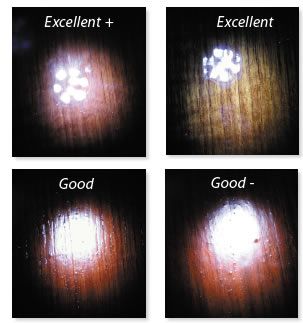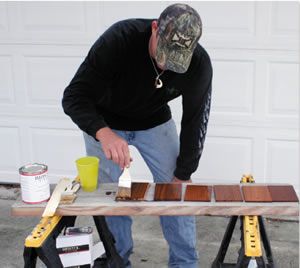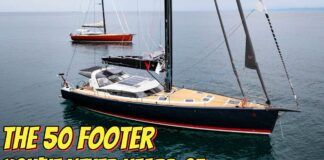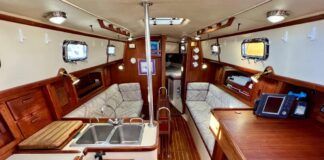After a brief-and for testers, much needed-hiatus from testing wood finishes, we recently launched a new long-term evaluation of exterior wood coatings. Our last round of tests, a two-year death match, wrapped up in 2011. Although the test field this go-around is smaller than the previous tests lineup, it includes some new products and some that have been reformulated since the last long-term test began in 2007.
In our last search for the ideal wood finish, the only products still showing Good or better performance after more than two years of testing were two-part varnishes, specifically Interlux Perfection, which rated Excellent for coating integrity and gloss retention but has been discontinued; Bonstone Nautithane, which rated Good for gloss and integrity; and Smiths Five-Year Clear, which is no longer being manufactured. (To see the full results of that test, check out the Exterior Wood Finish Test Two-year Update in the September 2011 issue online.)
But what is an ideal wood finish? The answer is obviously a subjective one, and will vary depending on who you ask. Brightwork lovers, who revel in a pristine, mirror-like finish and find varnishing to be a sort of therapeutic meditation, might say that the perfect wood finish is a two-part varnish that requires eight coats and in-between sanding; to them, the tradeoff of more prep and application time is justified with a harder, longer-lasting and more classic-looking finish. But if you ask the year-round, tropical sailor who values time on the water over a traditional look, they’re likely to tell you that the perfect product is cheap, easy and fast to apply, and even easier to maintain. (Who wants to spend time wielding a heat gun or Badger-bristle brush for days in row when the tradewinds are calling?) In our opinion, and for the purposes of this test, an ideal wood finish is defined as one that strikes a balance between easy application, easy maintenance, acceptable durability, and affordability.
We’ve yet to find the Holy Grail of wood coatings-one that offers easy application and upkeep, but lasts for years and years, and is cheap to boot. Instead, our findings have shown that as far as durability and aesthetics go, you get what you put into it: The more laborious the preparation and application, the longer lasting the protection, and the more professional-looking the finish. There are always tradeoffs, and deciding what your priorities are in a wood finish is key to determining which one is the ideal fit for you and your boat. (For help making that decision, check out the online version of this article, which includes Wood Coatings 101, a list of the pros and cons of each wood finish category.) Theres always the possibility that some manufacturer will one day formulate that Holy Grail varnish, so we try to remain optimistic as we continue our quest.
What We Tested
The coatings market is overflowing with options from hardware-store varnishes to outdoor-furniture finishes and boat-specific products. Unlike our last test, we limited this evaluations roster to marine-worthy, one- and two-part varnishes, varnish alternatives, and multi-step or multi-part systems from major marine-coatings manufacturers. We think this group offers a good cross-section of whats available to the average boat owner through chandleries, big-box stores, and online retailers. The products would be appropriate for finishing cockpit trim, toerails, and other exterior brightwork.
There are a total of 23 wood finishes in the test, including 14 one-part varnishes and varnish alternatives/synthetic coatings and nine two-part varnishes and multi-step systems. Represented makers include Epifanes, Interlux, Pettit, West Marine, Awlgrip, Bristol, Bonstone, Signature Finish, and WoodPlus.
We did not include teak sealers or teak oils. Designed to be re-applied frequently to maintain protection, these products do not fare as well in the weather-to-failure test setup. Well be following up this test with a long-term evaluation of teak sealers like Semco and Teak Wonder, and that test protocol will be more tailored to the products design.

| Product | Price | No. of Coats* | Recoat Time* | Sanding Between Coats Required | Application Ease | Initial Gloss |
|---|---|---|---|---|---|---|
| One-Part Varnishes | ||||||
| Epifanes Clear High Gloss | $25 / 500 ml | 7-8 coats | 24 hours | Yes | Good | Excellent |
| Interlux Schooner Gold | $42 / qt | 6-8 coats | 8-16 hours | Light sand between every other coat | Good | Good |
| Interlux Compass Clear | $22 / qt | 5-7 coats | 8-16 hours | Light sand between every other coat | Good | Excellent |
| Interlux Schooner | $33 / qt | 4-6 coats | 8-12 hours | Light sand between every other coat | Good | Excellent |
| Pettit Z-Spar 2015 Flagship | $37 / qt | 4 minimum | 18 hours | Light sand | Good | Excellent |
| Pettit Z Spar 1015 Captain’s Varnish | $32 / qt | 4 minimum | 12 hours | Light sand | Good | Excellent |
| Varnish Alternatives | ||||||
| Epifanes Rapidcoat semi-gloss tinted | $40 / 750 ml | 4-5 coats | 5-6 hours | No | Excellent | Good |
| Epifanes Rapidclear semi-gloss | $40 / 750 ml | 4-5 coats | 5-6 hours | No | Excellent | Good |
| Epifanes Woodfinish gloss | $29 / 500 ml | 5-7 coats | 24 hours | Recommended, not required within 72 hrs | Good | Excellent |
| Interlux Sikkens Cetol Marine Natural | $46 / qt. | 2 minimum | 24 hours | No | Excellent | Good |
| Interlux Sikkens Cetol Marine Light | $46 / qt. | 2 minimum | 24 hours | No | Excellent | Good |
| West Marine Woodshield Marine | $40 / qt. | 3 minimum | 12-20 hours | No | Excellent | Good- |
| West Marine Woodshield Natural | $40 / qt. | 3 minimum | 12-20 hours | No | Excellent | Good |
| Woodplus Marine-301 Honey Gold | $28 / liter | 2-3 coats | 4-6 hours | No | Excellent | Good- |
| Multi-Part and Multi-Step Varnish Systems | ||||||
| Epifanes PP Varnish Extra | $190 / 2000 ml | 4-6 coats | 2 hours | No | Excellent | Good+ |
| Interlux Perfection Plus | $80 / qt kit | 5-6 coats | 4-6 hours | Yes | Good | Excellent |
| Bonstone Nautithane Pro Urethane Coating | $70 / 1.5 qt kit | 4-6 coats | 3-5 hours | No | Good | Excellent+ |
| Bristol Traditional Amber Urethane High Gloss | $63 / qt kit | 6 minimum | 1-24 hrs.; varies by app method | Before last coat | Excellent | Excellent |
| Interlux Sikkens Cetol Marine Natural + Gloss overcoat | 94 ($46 + $48) | 4 (2 Cetol + 2 overcoat) | 24 hours | No | Excellent | Good |
| AwlGrip Awlwood J3809 Primer Clear + J3890 Gloss | 160 ($85 + $75) | 9 (1 primer + 8 gloss) | 1-3 hours | Recommended, not required if within 24 hrs. | Excellent | Excellent |
| AwlGrip Awlwood J9809 Primer Yellow + J3890 Gloss | 160 ($85 + $75) | 9 (1 primer + 8 gloss) | 1-3 hours | Recommended, not required if within 24 hrs. | Excellent | Excellent |
| AwlGrip Awlwood J7809 Primer Red + J3890 Gloss | 160 ($85 + $75) | 9 (1 primer + 8 gloss) | 1-3 hours | Recommended, not required if within 24 hrs. | Excellent | Excellent |
| Signature Finish Honey Teak + Clear Enamel | $257 / 100 sq. ft. kit | 5 (3 Honey Teak + 2 overcoat) | 1-3 hours | No, if overcoated within 8 hours | Good | Excellent |
How We Tested
The test products were applied to panels of bare teak from the same batch of scrap from Teakdecking Systems in Sarasota, Fla. Each product and its corresponding panel were assigned a number so that judging can be done blindly.
The products were applied according to maker instructions, except with regard to number of coats. To keep a degree of consistency, testers applied four coats of each product that called for more than three coats-including those that called for four, five, six, etc. coats. We did this to even the playing field in a way, as far as application, and to simplify application. That being said, in the real-world, you should always follow makers instructions, and skipping a required coat or two means you’re cheating the finish of some UV protection; the more coats of varnish you put on, the more protection and durability you will get. Finishes requiring a minimum of two coats, like Interluxs Cetol products, were given just two coats.
For ease of application ratings, testers considered how smoothly the product flowed on, how complete the instructions were, and how simple the process was. For example, products that did not require sanding between coats were rated higher than those that called for sanding between every coat; re-coat times, dry times, thinning coats, mixing two parts, etc. all factored into the application rating.
To rate the initial gloss, testers used a multi-bulb LED flashlight in a dark room. The coated test panels that showed a sharp reflection of the separate LED bulbs rated Excellent, while those that reflected only a single light beam werent rated as highly. Differences were so tiny that testers resorted to a plus-and-minus rating system to denote the negligible degrees of variation.
For the long-term test, the panels have been mounted onto a wood frame set at a 45-degree angle: The Rack. The Rack will live outdoors, in an unobstructed area in Sarasota, so that all of the panels will receive the same amount of exposure to the harsh Florida sunshine and other weather elements. Testers covered a section of each test panel to preserve its original gloss and color. This covered area will give us a baseline for comparing the finishes coating integrity, and their ability to retain gloss and color over time. Price and availability also will be considered in final ratings.
This introductory report focuses on the products ease of application and initial gloss, but the test will continue for at least two years, the max you can reasonably expect any exterior wood finish to last without touchups, especially in a super-sunny locale like south Florida. Checkups are planned for the six-month mark, and then annually. The panels will not receive any touchups or maintenance coats.
Awlgrip
In 2014, Awlgrip, an Akzo Nobel brand that has always been a favorite inPSs topside paint tests, released its Awlwood MA wood coating system. This fast-curing, two-step system involves a coat of primer (clear, yellow, or red) plus multiple coats of a topcoat (satin or gloss).
As we reported in the October 2014 Chandlery section, Awlwood is touted as offering the multi-season protection, abrasion resistance, and color retention of a hard varnish and the ease of application of teak treatment. According to the maker, the primers ability to deeply penetrate the wood and the topcoats UV absorbers give the finish lasting color, clarity, and gloss retention, thereby extending maintenance-coat times to multiple seasons. Awlwood also allows for multiple coats to be applied per day, and requires no sanding between coats, as long as the previous coat is sufficiently cured; however, the maker recommends sanding after the primer coat, then after every third coat, and before the final coat.
We launched a head-to-head test between Awlwood and Interluxs Cetol Natural in 2014, and after six months of weathering, the Awlwood coating appears unchanged. Testers corroborated the makers claims of easy application.
Bonstone Nautithane Pro
Bonstones Nautithane was our top pick in 2011 after two years of testing, and so far in this test, the performance of its successor, Nautithane Pro, has not disappointed.
A two-part. high-gloss, urethane coating, Nautithane Pro was a standout in our gloss test. The finishs mirror-like reflection even showed the outline of the flashlights face, not just the circular LED bulbs, earning it the only Excellent+ rating in the test field. The original Nautithane earned only a Good for initial gloss, so the formulas improvement over its predecessor is already evident.
Bonstone claims Nautithane Pro is more durable, more UV resistant, and easier to apply than the original. The maker noted better flow and quicker film building, meaning fewer coats are required. The original survived our last death match unscathed, so were looking forward to seeing how this new-and-improved product fares in the durability and gloss-retention tests.
Bristol Finish
The amber-hued Bristol Finish Traditional Amber two-part varnish, made by Lalandii Coatings, is an acrylic urethane system. The product has been reformulated with an upgraded resin base since the last time we tested it, according to its maker.
Testers rated the new Bristol as having an Excellent gloss and Excellent ease of application among its peers. The instructions offer three application methods to choose from: the wet-on-wet method, dry method, and the practical method. The practical method, which we of course chose, entailed very little sanding, making Bristol one of the easier two-parts to apply in this test.
In our last test, the original Bristol managed a good showing at one year, but it went downhill soon after. It will be interesting to see whether the improvements to that formula extend durability.

Epifanes
Of the 23 products we tested, five were made by Epifanes: Clear high-gloss one-part varnish; Rapidcoat semi-gloss, Rapidclear semi-gloss, and Woodfinish gloss varnish alternatives; and the PP Varnish Extra two-part varnish.
A traditional marine varnish, Epifanes Clear has been popular in wooden-boat circles for many years because of its high gloss and wet, traditional finish. It flows well, and thanks to its tung-oil base, the finish is more flexible than non-spar varnishes.
The Woodfinish test panel, with its amber hue, also had an Excellent gloss rating. Like the Clear, it has a tung-oil and phenolic-modified-resin base. While the finish looks similar to that of the Clear, its easier to apply (fewer coats and no sanding between coats within 72 hours). Time will tell whether that application bonus comes at a durability deficit.
The easiest of the Epifanes bunch to apply are the Rapidcoat and Rapidclear. Fast dry times, few required coats, and no sanding in between coats mean many boat owners could finish their project in two days using either of these products. Both are semi-gloss, earning Good gloss ratings in our test. The only difference between these two formulas is that Rapidcoat is lightly tinted, so it has a bit of a warmer look.
PP Varnish Extra has a comparatively fast recoat time for a two-part varnish, and its ease of application is on par with some others in its category. Epifanes claims it offers excellent abrasion resistance, but not much in the way of UV resistance. The maker suggests topcoating it with one of the other Epifanes wood products; we did not do this optional step for the test. Varnish Extra likely makes a better insulation coat, sealer, or filling coat for other varnish systems than it does a stand-alone finish.
Interlux
Since our last wood finish test wrapped, Interlux introduced three new exterior varnishes: Perfection Plus, a clear two-part polyurethane; Schooner Gold, a high-viscosity, quick-building varnish; and Compass, a fast-drying hybrid of classic tung oil and polyurethane. The original Perfection and Schooner formulas performed well in our past tests, so were eager to see how these improved products hold up. Were also testing the regular Schooner formula in this round.
Interlux claims the golden-colored Schooner Gold has advanced UV technology and extended durability. It has a higher viscosity than its sibling, Schooner, which means it can be applied in fewer coats, reducing application time and effort. Schooner Gold also doesn’t require sanding between coats, although it is recommended for a better finish. Schooner is more of a classic varnish and has an Excellent gloss; Schooner Gold is marketed to professionals and do-it-yourselfers.
Compass Clear has a polyurethane base, presumably making it highly durable and abrasion resistant. According to Interlux, Compass Clear also has additives for UV resistance plus stabilizers for long-term gloss and clarity. The clear finish shows the natural color of the wood, and offers an Excellent gloss.
Return contenders in our wood finish tests, the Cetol product line is well-known among boat owners. Early on, it got a bad rap for its muddy-looking appearance, but the newer formulations have resolved this issue-especially the Cetol Marine Natural Teak-and the products have been top picks among their peers in our past evaluations. They are very easy to apply, and as weve seen in field tests, they are easy to maintain. With a little attention once a year with a scrubby pad and a fresh coat, Cetol coatings will last the long haul. Well see how they fare in this go-around.
Pettit
The two Pettit products in this test, 2015 Flagship and 1015 Captains Varnish, are both one-part varnishes from the company’s Z-Spar product line, and both were Recommended products at the 18-month mark in our last test.
Both the amber-colored Captains and the warm-hued Flagship are well-regarded as traditional spar varnishes, combining phenolic and alkyd resins with tung and linseed oils. Both offer Excellent gloss and relatively easy application, but the Flagship formula is loaded with UV inhibitors, making it more likely to survive the Florida sunshine over time.
Signature Finish
The Signature Finish Honey Teak three-part, two-step systems application was surprisingly fast to apply; all coats, including the clear enamel overcoat, can be applied in one day. Scuffing lightly between coats with a red scuff pad is recommended only if prior coats have cured. It has a quick recoat time and flows on easily. The golden-colored, catalyzed acrylic urethane enamel coating was developed to withstand tropical weather and is touted for its resistance to chemicals like acetone, fuel, and battery acid.
The biggest drawback of the Honey Teak is its pricetag: $257 for a 100-square-foot kit. But the added bonus to using the Honey Teak system is its makers hands-on approach to customer service. The flipside to this, however, is that the product can only be purchased by calling the Florida-based company. According to company President Tom Fabula, Talking to customers on a one-to-one basis is important, so we can provide helpful hints to help them with their project, such as weather conditions, prepping the wood, masking to prevent leakage, and application methods.
Honey Teak has been a top performer in our tests for more than a decade; however, it was surpassed by Perfection and Nautithane in our last long-term evaluation.
West Marine
New to the test field this year are West Marines Wood Shield products, which are manufactured by Pettit. Similar to Interluxs Cetol line, the synthetic varnish alternatives come in two semi-translucent formulas, Wood Shield Marine and Wood Shield Natural; the Marine formula has a slight brown tint to its finish.
Wood Shield is easy to apply and maintain-requiring a minimum of three coats and no sanding between coats-and offers a flexible, breathable finish. West Marine advises that only a single maintenance coat need be done annually. It will be interesting to see how these products compare to the Cetol coatings over time.
WoodPlus
Another newcomer to the varnish-alternative category is WoodPlus Marine 301 Honey Gold. Marine 301 is a reformulated and improved version of the WoodPlus Marine Natural, which we tested in the last death match.
This new product was designed to offer better UV resistance and color retention than the Marine Natural, which mustered only a Fair for color retention at the one-year mark in our last test.
Testers noted that the Marine 301 was very easy to apply and rated Good- for initial gloss; its also the least expensive product in its category.
Conclusion
It is far too early in this round of testing to start picking Best Choice products, but there were a few notable findings to report with regard to initial gloss and application.
The panel with the hands-down best gloss of the bunch was the Nautithane Pro panel. Many of the other varnishes also had Excellent, wet-look finishes, but the Nautithane Pro was a standout for its sharp, crisp reflection, and deep, hard, mirror-like finish.
There was no outstandingly easy-to-apply product that led the pack. Synthetic teak treatments like Cetol are always going to be easier to apply than a varnish that requires more coats and considerable sanding like Perfection Plus, but these products will not appeal to the same type of boat owner either.
Quite a few products are Recommended at this stage in the test, but remember that these picks are based solely on the coatings performance out of the gate. To find the best options over the long haul, be sure to review our past reports on the last test of exterior wood finishes. You can find them in our online archive in the May 2009, January 2011, and September 2011 issues. Youll also find more detailed information on one-part and two-part varnishes in the August 2007 and December 2007 issues online, along with a guide to maintaining varnish in the December 2009 issue.
Stay tuned for the checkup reports on this long-term test.





































